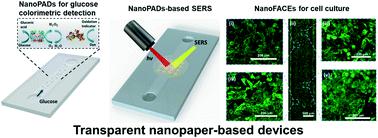Our official English website, www.x-mol.net, welcomes your
feedback! (Note: you will need to create a separate account there.)
NanoPADs and nanoFACEs: an optically transparent nanopaper-based device for biomedical applications.
Lab on a Chip ( IF 6.1 ) Pub Date : 2020-07-28 , DOI: 10.1039/d0lc00226g Binbin Ying 1 , Siwan Park , Longyan Chen , Xianke Dong , Edmond W K Young , Xinyu Liu
Lab on a Chip ( IF 6.1 ) Pub Date : 2020-07-28 , DOI: 10.1039/d0lc00226g Binbin Ying 1 , Siwan Park , Longyan Chen , Xianke Dong , Edmond W K Young , Xinyu Liu
Affiliation

|
Paper has been a popular material of choice for biomedical applications including for bioanalysis and cell biology studies. Regular cellulose paper-based devices, however, have several key limitations including slow fluid flow; large sample retention in the paper matrix for microfluidic paper-based analytical device (μPAD) application; serious solvent evaporation issues, and contamination and poor control of experimental conditions for cell culture. Here, we describe the development of two novel platforms, nanopaper-based analytical devices (nanoPADs) and nanofibrillated adherent cell-culture platforms (nanoFACEs), that use nanofibrillated cellulose (NFC) paper, simply called nanopaper, as the substrate material to create transparent, pump-free and hollow-channel paper-based microfluidic devices. Due to the natural hydrophilicity and nanoscale pore size of nanopaper, the hollow-channel microfluidic devices can realize a totally pump-free flow without any complicated surface chemical functionalization on the nanopaper. Experimental results showed that within a certain range, larger hollow channel size leads to faster pump-free flows. Different from previous designs of paper-based hollow-channel microfluidic devices, the high transparency of the nanopaper substrate enabled the integration of various optical sensing and imaging technologies together with the nanoPADs and nanoFACEs. As proof-of-concept demonstrations, we demonstrated the use of nanoPADs for colorimetric sensing of glucose and surface-enhanced Raman spectroscopy (SERS)-based detection of environmental pollutants and applied the nanoFACEs to the culture of human umbilical vein endothelial cells (HUVECs). These demonstrations show the great promise of nanoPADs and nanoFACEs for biomedical applications such as chemical/bioanalysis and cell biology studies.
中文翻译:

NanoPAD和nanoFACE:一种基于光学透明纳米纸的生物医学设备。
纸已成为包括生物分析和细胞生物学研究在内的生物医学应用的首选材料。但是,常规的纤维素纸基设备有几个关键限制,包括缓慢的流体流动;在基于微流体纸质分析设备(μPAD)的应用中,纸质基质中的样品保留量大;严重的溶剂蒸发问题,污染以及对细胞培养实验条件的不良控制。在这里,我们描述了两种新型平台的开发,即基于纳米纸的分析设备(nanoPAD)和纳米纤维化的贴壁细胞培养平台(nanoFACE),它们使用纳米纤维化的纤维素(NFC)纸(简称为纳米纸)作为基材来创建透明材料,无泵和空心通道纸基微流控设备。由于纳米纸的天然亲水性和纳米级孔径,中空通道微流体装置可以实现完全无泵的流动,而无需在纳米纸上进行任何复杂的表面化学功能化。实验结果表明,在一定范围内,较大的中空通道尺寸导致更快的无泵流动。与以前的纸基空心通道微流体设备设计不同,纳米纸基材的高透明性使各种光学传感和成像技术与nanoPAD和nanoFACE集成在一起。作为概念验证的演示,我们证明了使用nanoPADs进行比色葡萄糖检测和基于表面增强拉曼光谱(SERS)的环境污染物检测,并将nanoFACEs应用于人脐静脉内皮细胞(HUVECs)的培养。这些演示展示了nanoPAD和nanoFACE在生物医学应用(如化学/生物分析和细胞生物学研究)中的巨大前景。
更新日期:2020-09-15
中文翻译:

NanoPAD和nanoFACE:一种基于光学透明纳米纸的生物医学设备。
纸已成为包括生物分析和细胞生物学研究在内的生物医学应用的首选材料。但是,常规的纤维素纸基设备有几个关键限制,包括缓慢的流体流动;在基于微流体纸质分析设备(μPAD)的应用中,纸质基质中的样品保留量大;严重的溶剂蒸发问题,污染以及对细胞培养实验条件的不良控制。在这里,我们描述了两种新型平台的开发,即基于纳米纸的分析设备(nanoPAD)和纳米纤维化的贴壁细胞培养平台(nanoFACE),它们使用纳米纤维化的纤维素(NFC)纸(简称为纳米纸)作为基材来创建透明材料,无泵和空心通道纸基微流控设备。由于纳米纸的天然亲水性和纳米级孔径,中空通道微流体装置可以实现完全无泵的流动,而无需在纳米纸上进行任何复杂的表面化学功能化。实验结果表明,在一定范围内,较大的中空通道尺寸导致更快的无泵流动。与以前的纸基空心通道微流体设备设计不同,纳米纸基材的高透明性使各种光学传感和成像技术与nanoPAD和nanoFACE集成在一起。作为概念验证的演示,我们证明了使用nanoPADs进行比色葡萄糖检测和基于表面增强拉曼光谱(SERS)的环境污染物检测,并将nanoFACEs应用于人脐静脉内皮细胞(HUVECs)的培养。这些演示展示了nanoPAD和nanoFACE在生物医学应用(如化学/生物分析和细胞生物学研究)中的巨大前景。











































 京公网安备 11010802027423号
京公网安备 11010802027423号